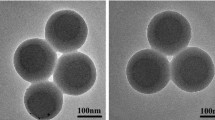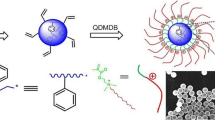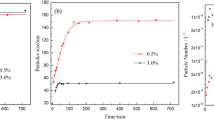Abstract
Uniform polystyrene (PS) microspheres prepared for deposition of metallic nanoparticles were synthesized using the surfactant-free emulsion polymerization based on styrene/potassium persulfate/water (St/KPS/H2O) system. Owing to the presence of sulfate groups, the PS microspheres can be utilized to reduce gold nanoparticles without adding extra reducing agent into the mixture. The synthesis and characterization of metal-polystyrene nanocomposites are reported, and a possible reduction mechanism is proposed: by heating the aqueous solution in the presence of metal ions and PS, the sulfate chain end groups of the PS hydrolyzed and transformed to hydroxyl groups firstly. The hydroxyl groups function as a reducing agent, and carboxylic groups provide a site to adsorb the gold nuclei. The Au nanoparticles grow in size with the coalescence and dissolving of nuclei through the Ostwald ripening process. The PS microspheres and Au nanoparticles were characterized by Fourier transform infrared spectroscopy, X-ray photoelectron spectroscopy, transmission electron microscopy, X-ray power diffraction, and thermal gravimetric analysis.









Similar content being viewed by others
References
Liang Z, Susha A, Caruso F (2003) Chem Mater 15:3176
Lu Y, Mei Y, Schrinner M, Ballauff M, Moller MW, Breu J (2007) J Phys Chem C 111:7676
Yang X, Zhang Y (2004) Langmuir 20:6071
Chen CW, Serizawa T, Akashi M (1999) Langmuir 15:7998
Dokoutchaev A, James JT, Koene SC, Pathak S, Prakash GKS, Thompson ME (1999) Chem Mater 11:2389
Xia H, Zhang Y, Sun S, Fang Y (2007) Colloid Polym Sci 285:1655
Wang PH, Pan CY (2000) J Appl Polym Sci 75:1693
Mohammed HS, Shipp DA (2006) Macromol Rapid Commun 27:1774
Yong KT, Sahoo Y, Swihart MT, Prasad PN (2006) Colloids Surf A: Physicochem Eng Aspects 290:89
Pol VG, Grisaru H, Gedanken A (2005) Langmuir 21:3635
Shi W, Sahoo Y, Swihart MT, Prasad PN (2005) Langmuir 21:1610
Tian C, Wang E, Kang Z, Mao B, Zhang C, Lan Y, Wang C, Song Y (2006) J Solid State Chem 179:3270
Mei Y, Lu Y, Polzer F, Ballauff M (2007) Chem Mater 19:1062
Raveendran P, Goyal A, Blatchford MA, Wallen SL (2006) Mater Lett 60:897
Note C, Koetz J, Kosmella S, Tiersch B (2005) Colloid Polym Sci 283:1334
Lee CL, Wan CC, Wang YY (2001) Adv Funct Mater 11:344
Kim DW, Lee JM, Oh C, Kim DS, Oh SG (2006) J Colloid Interface Sci 297:365
Ou JL, Chang CP, Sung Y, Ou KL, Tseng CC, Ling HW, Ger MD (2007) Colloids Surf A: Physicochem Eng Aspects 305:36
Tseng CC, Kuo JL, Chang CP, Hwu WH, Ger MD (2007) Paper presented at the 20th international microprocesses and nanotechnology conference, International Conference Center, Kyoto, Japan (MNC 2007), paper no. 147
Ou JL, Yang JK, Chen H (2001) Eur Polym J 37:789
Cao L, Zhu T, Liu Z (2006) J Colloid Interface Sci 293:69
Huang H, Yang X (2005) Colloids Surf A: Physicochem Eng Aspects 255:11
Grace AN, Pandian K, Yang X (2006) Colloids Surf A: Physicochem Eng Aspects 290:138
Lee JH, Kamada K, Enomoto N, Hojo J (2007) J Colloid Interface Sci 316:887
Xu K, Guo ZR, Gu N (2009) Chin Chem Lett 20:241
Sun Y, Xia Y (2002) Science 298:2176
Vanderhoff JW (1980) Pure & Appl Chem 51:1263
Rodríguez AM, Vílchez MAC, Álvarez RH (1996) Colloids Surf A: Physicochem Eng Aspects 108:263
Bastos D, Hidalgo-Álvarez R, De las Nieves FJ (1996) J Colloid Interface Sci 177:372
Polzonetti G, Russo MV, Furlani A, Infante G (1993) Chem Phys Lett 214:333
Moore RGC, Evans SD, Shen T, Hodson CEC (2001) Physica E 9:253
Lala NL, Deivaraj TC, Lee JY (2005) Colloids Surf A: Physicochem Eng Aspects 269:119
Deivaraj TC, Lala NL, Lee JY (2005) J Colloid Interface Sci 289:402
Radha N, El-Sayed MA (2003) J Am Chem Soc 125:8340
Chung C, Lee M (2004) Bull Korean Chem Soc 25:1461
Tseng CC, Chang CP, Ou JL, Sung Y, Ger MD (2009) Colloids Surf A: Physicochem Eng Aspects 333:138
Author information
Authors and Affiliations
Corresponding author
Electronic supplementary material
ESM 1
(DOC 65 kb)
Rights and permissions
About this article
Cite this article
Chang, CP., Tseng, CC., Ou, JL. et al. Growth mechanism of gold nanoparticles decorated on polystyrene spheres via self-regulated reduction. Colloid Polym Sci 288, 395–403 (2010). https://doi.org/10.1007/s00396-009-2134-9
Received:
Revised:
Accepted:
Published:
Issue Date:
DOI: https://doi.org/10.1007/s00396-009-2134-9




